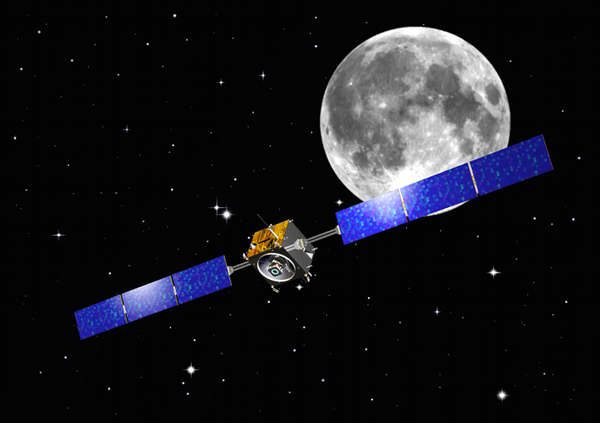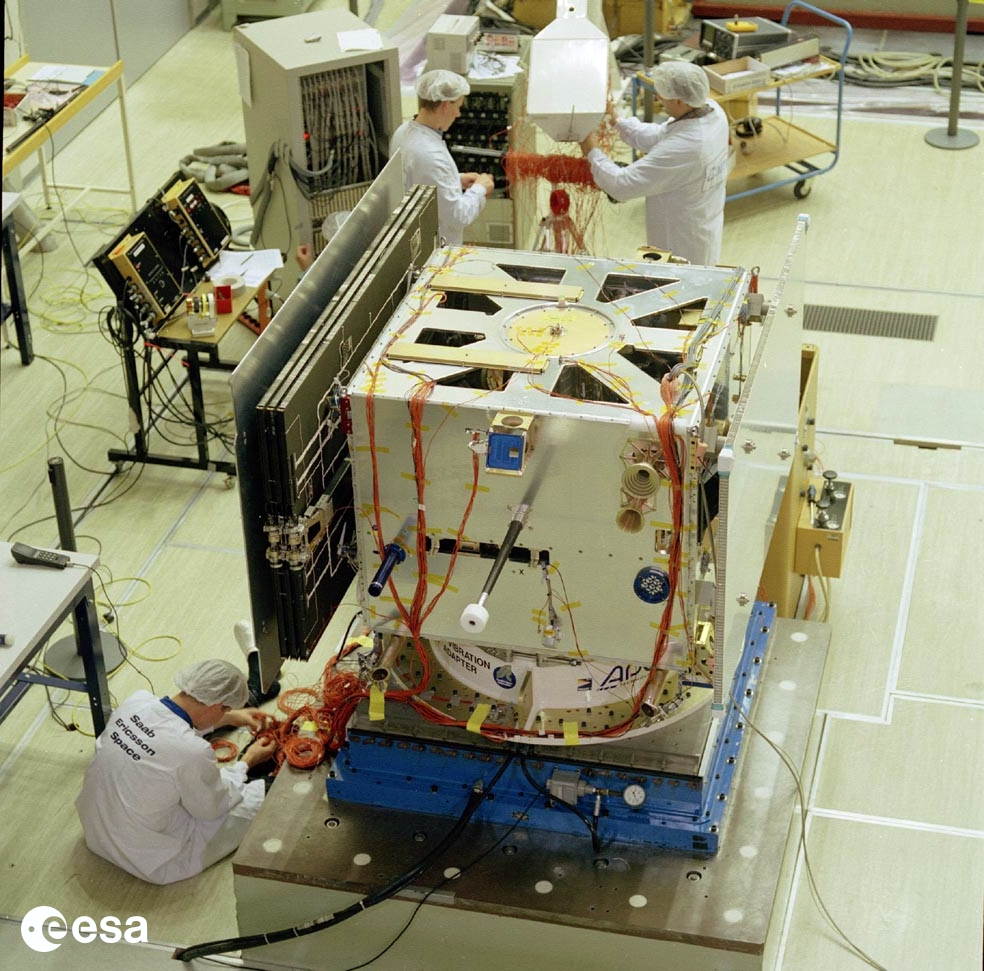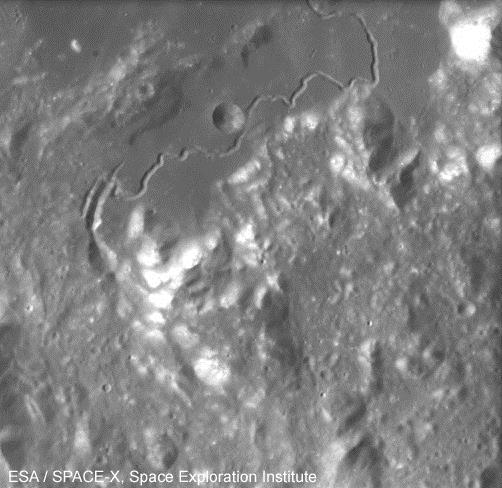Home - SMART-1
SMART-1 SMALL MISSION FOR ADVANCED RESEARCH IN TECHNOLOGY : EUROPE TO THE MOON
SMART-1 has been the first Small Mission for Advanced research in Technology in the ESA Scientific Programme to prepare the technology for future Cornerstone missions. SMART-1 demonstrated the use of Solar Electric Primary Propulsion (SEPP) and has been first ESA mission to the Moon. SEPP will have applications for the Mercury cornerstone BepiColombo. Future deep space missions, as will benefit from the timely development of SEPP technology. Several other technologies have been tested on SMART-1, involving spacecraft subsystems, SEPP diagnostics, and instruments that will be useful for a wide range of future missions. ESA’s SMART-1 mission to the Moon achieved record firsts such as:
- first Small Mission for Advanced Research and Technology; with spacecraft built and integrated 2.5 years and launched 3.5 years after mission approval;
- first mission leaving the Earth orbit using solar power alone (with Solar Electric Primary Propulsion);
- most fuel effective mission (60 l of Xenon) and longest travel (13 month) to the Moon!;
- first ESA mission reaching the Moon and first European views of lunar poles;
- first European demonstration of a wide range of new technologies: Li-Ion modular battery, deep-space communications in X- and Ka-bands, and autonomous positioning for navigation;
- first lunar demonstration of an infrared spectrometer and of a Swept Charge Detector Lunar X-ray fluorescence spectrometer ;
- first ESA mission with opportunity for lunar science, elemental geochemistry, surface mineralogy mapping, surface geology and precursor studies for exploration;
- first controlled impact landing on the Moon with real time observations campaign;
- first mission supporting goals of the International Lunar Exploration Working Group (ILEWG) in technical and scientific exchange, international collaboration, public and youth engagement;
- first mission preparing the ground for ESA collaboration in Chandrayaan-1, Chang’ E1 and future international lunar exploration.
Europe to the Moon with ion engines and miniaturised technologies
SMART-1 stands for ESA’s 1st Small Mission for Advanced Research and Technology. Its main objective has been achieved to demonstrate Solar Electric Primary Propulsion (SEPP) for future Cornerstones (such as Bepi-Colombo) and to test new technologies for spacecraft and instruments. The SMART-1 365 kg spacecraft was launched on 27 Sept. 2003, as an Ariane-5 auxiliary passenger and injected in GTO Geostationary Transfer Orbit, then spiraled out using ion propulsion until lunar capture in November 2004. The SMART-1 spacecraft reached on 15 March 2005 a lunar orbit of 400-3000 km for a nominal science period of six months, with 1 year extension until impact on 3 September 2006. SMART-1 science payload, with a total mass of 19 kg, featured many innovative instruments and advanced technologies, with a miniaturized high-resolution camera (AMIE) for lunar surface imaging, a near-infrared point-spectrometer (SIR) for lunar mineralogy investigation, and a very compact X-ray spectrometer (D-CIXS) for fluorescence spectroscopy and imagery of the Moon's surface elemental composition. The payload also included two plasma experiments: SPEDE (Spacecraft Potential, Electron and Dust Experiment,) and EPDP (Electric propulsion diagnostic Package), an experiment (KaTE) that demonstrated deep-space telemetry and tele-command communications in the X and Ka-bands, a radio-science experiment (RSIS), a deep space optical link (Laser-Link Experiment), using the ESA Optical Ground station in Tenerife, and the validation of a system of autonomous navigation (OBAN) based on image processing. Find more information about SMART-1 Mission at SMART-1 General Project Pages on the Sci-Tech Portal.
 |
 |
| Artists impression of the SMART-1 mission | SMART-1 spacecraft during integration/testing at ESTEC |
SMART-1 instruments and lunar science
Earth and Moon have shared a common history for 4500 million years. Knowing the Moon more thoroughly will help scientists to understand our home in space. SMART-1 science investigations include studies of geophysical processes (volcanism, tectonics, cratering, erosion, space weathering, polar processes) for comparative planetology, of the chemical composition of the Moon, and high resolution studies in preparation for future steps of lunar exploration. The mission addressed several topics such as the accretional processes that led to the formation of rocky planets, and the origin and evolution of the Earth-Moon system. A package of three spectroscopy and imaging instruments performed science at the Moon.
AMIE (Advanced-Moon micro-Imager Experiment) is a miniature high resolution (35 m pixel at 350 km perilune height) camera, equipped with a fixed panchromatic and 3-colour filter, for Moon topography and imaging support to other experiments. The micro camera AMIE has provided high-resolution CCD images of selected lunar areas. It included filters deposited on the CCD in white light + three filters for colour analyses, with bands at 750 nm, 900 nm and 950 nm (measuring the 1 μm absorption of pyroxene and olivine). AMIE images provided a geological context for SIR and D-CIXS data, and colour or multi-phase angle complement. Photometric anomalies associated to regolith roughness, ejecta blankets, lunar swirls were mapped and modelled. AMIE has been used to map sites of interest, in the South Pole–Aitken basin that are relevant to the study of cataclysm bombardment, and to preview future sites for sampling return. Lunar North polar maps and South pole) repeated high resolution images have been obtained, giving a monitoring of illumination to map potential sites relevant for future exploration.
SIR (SMART-1 Infra-Red Spectrometer) has been operating in the 0.9-2.6 μm wavelength range and carrying out mineralogical survey of the lunar crust. SIR had high enough spectral resolution to separate the pyroxene and olivine signatures in lunar soils. SIR data with spatial resolution as good as 400 m permitted to distinguish units on central peaks, walls, rims and ejecta blankets of large impact craters, allowing for stratigraphic studies of the lunar crust. We learned from SIR experience for the SIR-2 improved instrument that was launched on the 22nd October 2008 on India's Chandrayaan-1 mission to the Moon.
D-CIXS (Demonstration of a Compact Imaging X-ray Spectrometer) is based on novel detector and filter/collimator technologies, and has performed the first lunar X-ray fluorescence global mapping in the 0.5–10 keV range, in order to map the lunar elemental composition. It was supported in its operation by XSM (X-ray Solar Monitor) which also monitored coronal X-ray emission and solar flares. Bulk crustal composition has bearing on theories of origin and evolution of the Moon. D-CIXS produced the first global measurements of the lunar surface in X-ray fluorescence (XRF). For instance, D-CIXS measurements of Si, Mg, Al, Ca and Fe lines were made over North of Mare Crisium during the 15 Jan 2005 solar flare, permitting the first detection of Calcium from lunar orbit. Scientific observations made during two solar flare events and show the first detection of Titanium from the lunar surface. We learned from the experience of D-CIXS to aid the design of Chandrayaan-1 X-ray spectrometer (C1XS).The X-ray Solar Monitor XSM has been used to calibrate DCIXS measurements, and to monitor solar X-ray variations during flares in conjunction with other space solar observatories.
The experiments have been run according to illumination and altitude conditions during the nominal science phase of 6-months and 1 year extension, in elliptical Moon orbit. The planning and co-ordination of the Technology and science experiments operations was carried out at ESA/ESTEC (SMART-1 STOC). The SMART-1 data are available at ESA Planetary Science Archive, based on the PDS (Planetary Data System) Standard. Even if SMART-1 was primarily a technology demonstration mission, it has provided opportunities for science and exploration studies.
To date, more than 80 refereed papers and more than 370 conference or technical papers have been published based on SMART-1 (see ADS or Cosmos website). SMART-1 data are accessible at ESA Planetary Science Archive PSA. SMART-1 highlights and results have also been shared with the public and youth, giving visibility to European space activities.
List of SMART1 related refereed publications:
 |
 |
| South Pole (Credit: Foing, Ellouzi & ESA/SMART-1/AMIE) | View Hadley Rille near Apollo 15 landing site |
- Removed a total of (4) style text-align:center;
- Removed a total of (4) style float:left;








































 Sign in
Sign in
 Science & Technology
Science & Technology